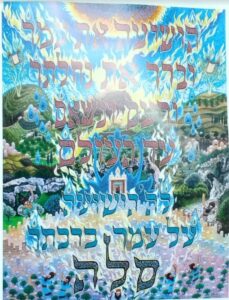Mishpatim 2023
בס”ד
By Rabbi Moshe Goodman, Kollel Ohr Shlomo, Hebron
The Mountains of The Covenant

The end of this parsha discusses the covenant made between Hashem and Israel at the giving of the Torah. This painting which has two mountains, apparently depicting mount Grisim and mount Eval, “the mountains of the covenant,” with trees and sefer Torahs at their tops, quite clearly carries this theme of covenant. The trees with sefer torahs seem to represent the verse “it [the Torah] is a tree of life.” The sefer torah is winged, giving a it a heavenly status, while it is found on a tree that is rooted to the earth, thus expressing an idea of bridging heaven and earth through the torah and the covenant.
The two central verses both have the themes of salvation upon God’s People. This may be seen to complement the theme of covenant in this painting by saying that salvation comes from the unity of Israel to Hashem through keeping the covenant. The words for salvation here “hoshiah” and “hayeshuah” both have the Tetragrammaton embedded within them plus the letters shin ayin numerically equivalent to 370, which Kabbalisitically refer to the 370 supernal lights of compassion and blessing. This blessing may be hinted to by the drops of dew in this painting as the verse of blessing says “may Hashem give you from the dew of the heavens.” Interestingly, also the word yeshua has the numerical value of dew – “tal” – times ten with the collective [called “kollel”] = 391.
Of the “salvation drops” we see eleven of them taking on supernatural status for they are encompassed by a yellowish flame and the flame is encompassed by a a larger water drop. Five of these drops are seen to the right while six are seen to the left. This may indicate the two letters of the Tetragrammaton “vav”=6 and “heh”=5, which Kabbalistically hint to sparks that descended at the “shattering of vessels” that are raised from below and then return and descend from above united with aspects of compassion and kindness hinted to by drops of water, a symbol of kindness according to the Kabbalah.
Also bridging these two themes of kindness and judgment are the colors of the two verses: the top verse which has more emphasis on the request to save Israel is in red, the color of judgment [and fire], while the lower verse which has more emphasis on the salvation from Hashem is painted in blue, the color of kindness [and water]. Also we should note that the top verse is commonly used when counting men for a minyan, a matter that suggests the effort upon Israel, as in making a minyan, towards the resting of the Holy Presence upon them. Bridging these two verses the Temple is found and the letter Shin meant to hint t o the Name Shaddai and the Holy Presence associated with the Holy Name. This may mean that the Holy Presence at the Temple stands as the connection between Hashem, emphasized in the bottom verse, and Israel, emphasized in the top verse.
We see seven hasidim, three to the right, three to the left, all blowing shofars, and a central hasid at the bottom not blowing a shofar. This layout suggests the Menora, also considered by our Sages as a a symbol of the Holy Presence. This layout also resembles the layout of the days of the week, which the Kabbalists describe as being three before Shabbat, three after Shabbat, and Shabbat, which has no work and no “blowing of the shofar,” at the center between the two groups of three days.
Hebron, City of the Patriarchs, encompasses these ideas, for here the covenant of the Patriarchs is especially remembered by Hashem, and here heaven and earth meet and become united – “hibur/Hebron – as a focal point of the Holy Presence.